A version of this article first appeared in my column for Classic Movie Hub, in March 2020. I revised it a bit for REALLY Old Films Month.
If I challenged you to name the first person who ever shot moving images on film, how would you respond? “Thomas Edison”? “The Lumière brothers”? “William K.-L. Dickson,” if you’re a film history buff? Maybe you would try to be smart and shout “Eadweard Muybridge!” Not a bad guess, my friend–but I did say “on film.”
While it’s often debated who should be credited for inventing moving pictures per se–this debate would include Muybridge and the inventors of various optical illusion toys–the first man to shoot images on familiar film strips was the distinguished-looking Louis Le Prince. A true pioneer of the cinema, his story is extraordinary not just for what it tells us about his contributions to a brand-new art form, but for how it ends–in a tragic mystery that remains unsolved to this day.
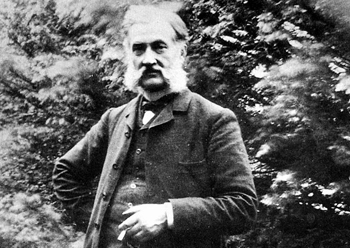
Louis Aimé Augustin Le Prince was born to a military family in France in 1841. His father was a major of artillery in the French army who had received the Légion d’honneur. While growing up Le Prince spent time in the studio of family friend Louis Jacques Mandé Daguerre, who taught him about photography. (Yes, that Daguerre, inventor of the famed daguerreotype.) As a young man the talented Le Prince would also study art in Paris and chemistry in Leipzig, Germany. These varying fields of study would all play their part in the future inventor’s work.

In 1866 he moved to England to work for his friend John Whitley, who had started a brass foundry. He would wed Whitley’s sister Elizabeth, an artist, in 1869. The Le Princes soon founded a school for the “applied arts”–making everyday objects both functional and beautiful. They started experimenting with making photographs on metal and pottery, which gained them some fame and even a commission to create portraits of Queen Victoria and Prime Minister William Gladstone. (Interestingly enough, these two portraits were included in an 1878 time capsule that was installed under Cleopatra’s Needle in London, where it remains to this day).
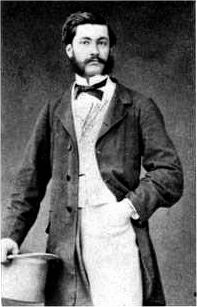
In 1881 Le Prince travelled to the U.S. as a Whitley Partners agent. He became a manager for an artist group that specialized in panoramas that were exhibited throughout the country. It was around this time that he took the leap from tinkering with still photographs to examining the idea of “moving” photographs. Thanks to Eadweard Muybridge, this was a big topic of interest to inventors at the time. Le Prince’s first experiment resulted in a chunky camera with no less than 16 lenses. By taking tons of photos of moving subjects at slightly different angles, this machine certainly captured some kind of movement, but the images were pretty wobbly.
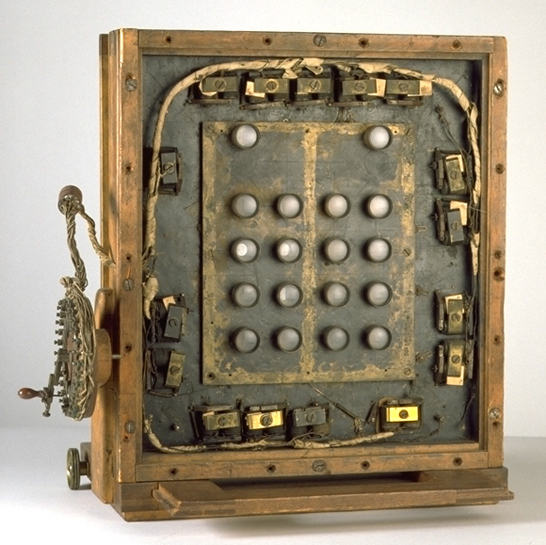
Heading back to England in 1887, Le Prince designed a more straightforward single-lens camera in a workshop in Leeds. Resembling a stubby wooden box, it used paper negatives and photographed 12 to 20 frames per second. On October 14 1888 he visited Oakwood Grange, the Whitleys’ home, and shot his first film with the new machine. It was simple footage showing his son Adolphe, Joseph and Sarah Whitley, and friend Annie Hartley walking in circles around their garden (clearly with amusement). Surviving at only a few seconds long, it’s the world’s oldest “shot on film” motion picture.
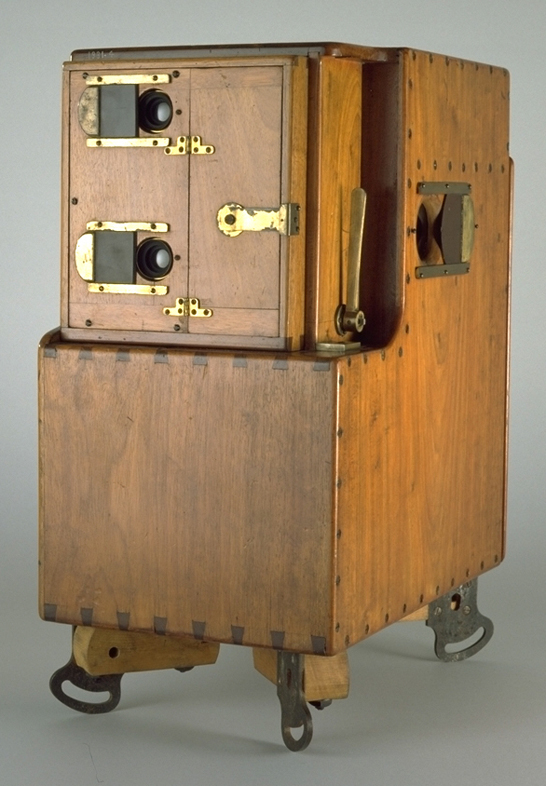
The equally-brief films Traffic Crossing Leeds Bridge and Accordion Player (again featuring Adolphe) were filmed soon afterwards. Satisfied with his new camera, Le Prince began work on a projector with an eye to a future patent. Family later claimed that he successfully projected still images in his Leeds workshop. Unfortunately, the public would never see the results of his hard work.

In 1890, Le Prince decided to move back to the U.S. permanently and planned on holding public demonstrations of his machines, much like Edison and the Lumière brothers would do years later. That September, with his wife and children already waiting for him in their newly-renovated New York mansion, Le Prince packed up his inventions and prepared for the lengthy journey. It would start by going to France, where Le Prince wanted to visit family and friends before heading across the Atlantic. On September 16 his brother Albert watched him board the train in Dijon, heading to Paris. When the train arrived in Paris, however, Le Prince was not on it.
His bags had also never arrived–indeed, there was no trace of Le Prince or his bags on board the train at all. No strange behavior had been reported in either the Dijon station or on the train, and no bodies had been discovered along the route. Le Prince had simply vanished without a trace.
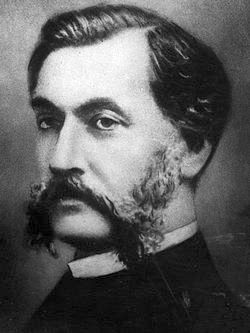
And that’s all we know about this strange case to this very day. Not that this has stopped numerous theories from swirling through the years, some more plausible than others. The most common ones:
Suicide–Supposedly Le Prince was facing bankruptcy and feeling trapped; however, this seems very doubtful since he was devoted to his family and had clearly arranged to move to New York. He was also looking forward to demonstrating his exciting new inventions.
Fratricide–Since his brother Albert was the last person to see Le Prince alive, this has aroused some suspicion. However, there’s no evidence of any animosity between the brothers–in fact, surviving letters show the Le Princes were a close and loving family.
Assassination–This theory’s gained the most steam since it involves the frenetic 19th century patent wars. The story goes that Edison (always the cartoon villain in these stories) wanted full control over the moving picture industry and made Le Prince “disappear” before he could file new patents. A pretty melodramatic theory, and if we consider the sheer number of inventors around the world creating cameras at the time it seems pretty fruitless for Edison to single out this one Frenchmen. Le Prince’s widow apparently favored this theory, but there’s never been any evidence to back it up.
Today, Le Prince’s great-granddaughter Laurie Snyder (interviewed by the BBC in 2015) leans toward a simpler explanation. She pointed out that Le Prince apparently took a later train from Dijon than his Paris friends expected–hence why he and his bags didn’t arrive when they thought he was due. He likely arrived around 11 p.m. in Paris and was attacked by a robber, perhaps a hansom cabman who could’ve been alone with Le Prince for significant stretches of time. Violent robbers targeting lone travelers who were apparently a problem in Paris at the time. Could he have been robbed, knocked out and thrown into the Seine? Snyder thinks it’s possible.

We will likely never know exactly what happened to Louis Le Prince. But in any case, despite his tragic end Le Prince had just enough time to make a massive and lasting contribution to film history. And this writer feels that he certainly deserves the title of “The Father of Cinema.”
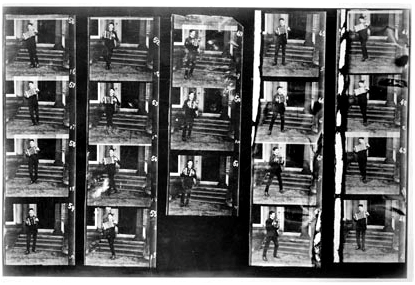
—
Tidbit: In 2003, a photo from the Paris police archives surfaced showing an 1890 drowning victim who strongly resembles Le Prince. An interesting addition to the mystery, although there’s no proof the victim was him.
The interview with Laurie Snyder can be found here:

I learn so much from you!!! Thank you!!! …and what a CRAZY story!!!!!
Enjoy your day!
Isn’t it? One of the strangest mysteries of film history…
Laurie Snyder’s theory is by far the most likely explanation. Although, it’s odd that Le Prince didn’t send a telegram to his friends who were to meet him at the station letting them know he would be arriving on a later train. Le Prince’s luggage and its contents may have been pawned and are waiting to be found in somebody’s attic. They certainly weren’t tossed into a dark alley to be found by the police and connected to the missing Le Prince. An investigation into the Paris police records from 1885 thru 1890 would reveal how many and at what time robbery/murders were committed, which would provide supporting evidence for Snyder’s theory.
I give an A+ to Lea for her investigation and conclusions of this unsolved, and unsolvable, mystery.
There could’ve been some miscommunication between Le Prince and friends before he got on the train, I’m guessing. In any case, Snyder’s theory makes more sense to me than Edison assassins or a sudden desire to be no more.
Fascinating story, and one that will never have an ending, most likely. I’m curious about the 16-lens camera. Did you find any information about how photos from different angles would suggest motion? And by being “wobbly,” does that mean the resulting images were mounted on something that was moving?
I thiiiink each lens took a photo in succession, creating an illusion of movement when you strung the photos together (a la Muybridge). Since they were in slightly different spots the image wouldn’t be a little wobbly looking. IIRC, would have to look it up to be sure.
No!! It was Edison and his team of ninja assassins that did Le Prince in! No other explanation makes sense!!
But for real, great article.
Or the other obvious theory–ALIENS. 😀
A great case for Sherlock Lea 🙂 As always, I learnt a lot from your work.
Was there any film made from that case?
Not that I know of, it would make a good dramatic documentary for sure!
Fascinating story, Lea. Thank you!
You’re welcome Stiiv!
A mystery indeed. Poor Monsieur Le Prince! I agree with Laurie’s explanation- some crook/robber was responsible for his disappearance. As for his things not being found that would make sense- the crook would have disposed of what he couldn’t use or didn’t want so as not to leave any clues back to him. Regarding Monsieur Le Prince not sending a telegram to let his folks know he would be on the later train- maybe he didn’t have the time, or the telegram machine wasn’t working?
Perhaps the telegram got lost somewhere along the way? If anything we know communication wasn’t as effortless back then as it is now.
Pingback: It’s Silent-ology’s 9th Anniversary! | Silent-ology
My name is David Wilkinson and I directed THE FIRST FILM proving the Le Prince story. You have my photo above. Check out IMDb for further information
I need to contact Laurie Snyder and the email I had in 2015 is not live.
I have some important information for her.
Thank you
Very cool, David! I’m afraid I’m not in touch with Laurie Snyder, maybe someone else reading this is…
Thomas Edison hated anyone who would invent anything that would bring them fame and fortune over Edison. Look what happen to Tesla. So it would not suprise me that Edison had some to do with Le Prince not getting a patent for his movie machine
Well, I’ve often felt that with the sheer number of inventors vying for different patents, and with the many projects going on at the Edison labs every day, that he’d hardly have time to breathe let alone sabotage someone’s life…but, there’s always possibilities.